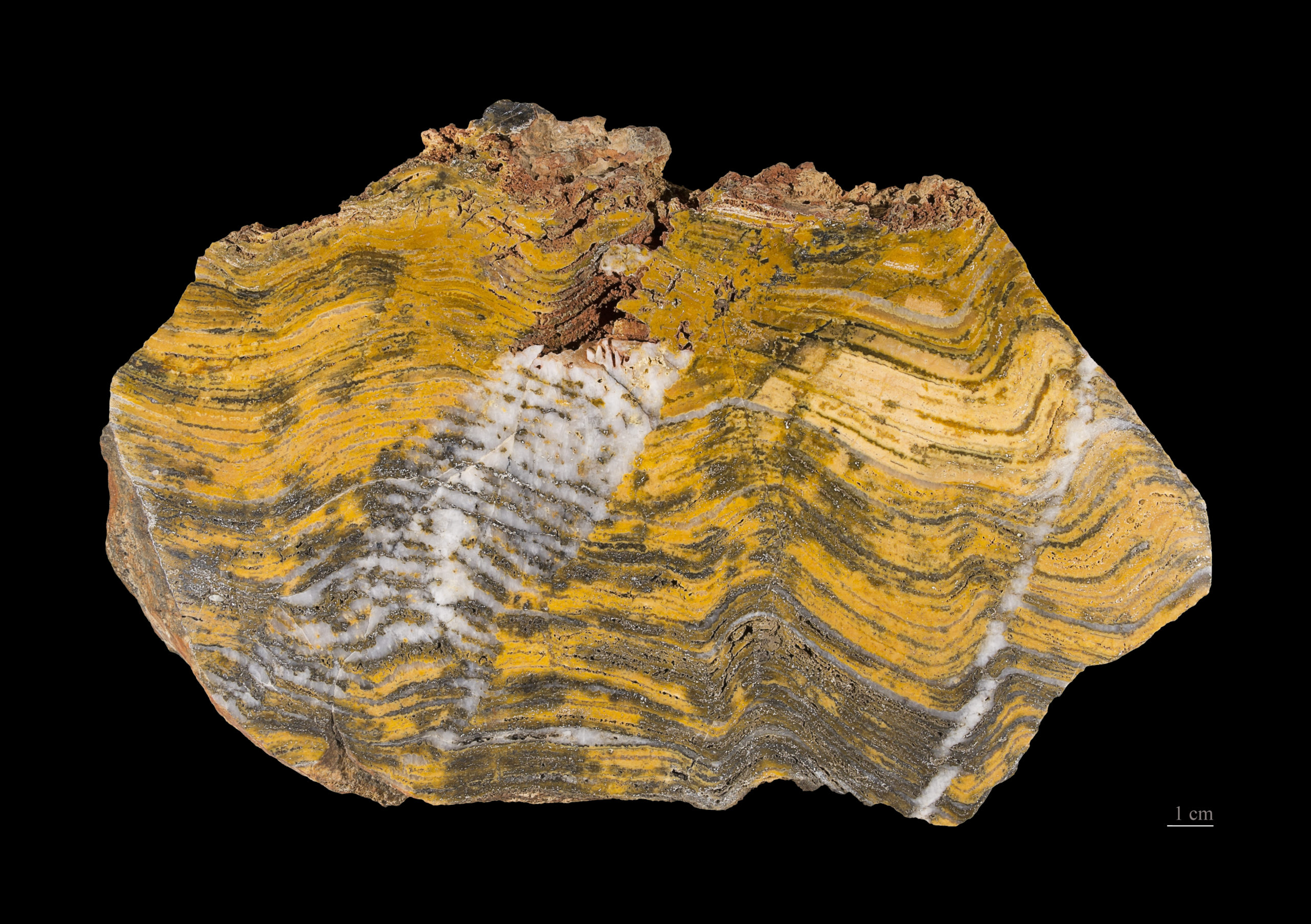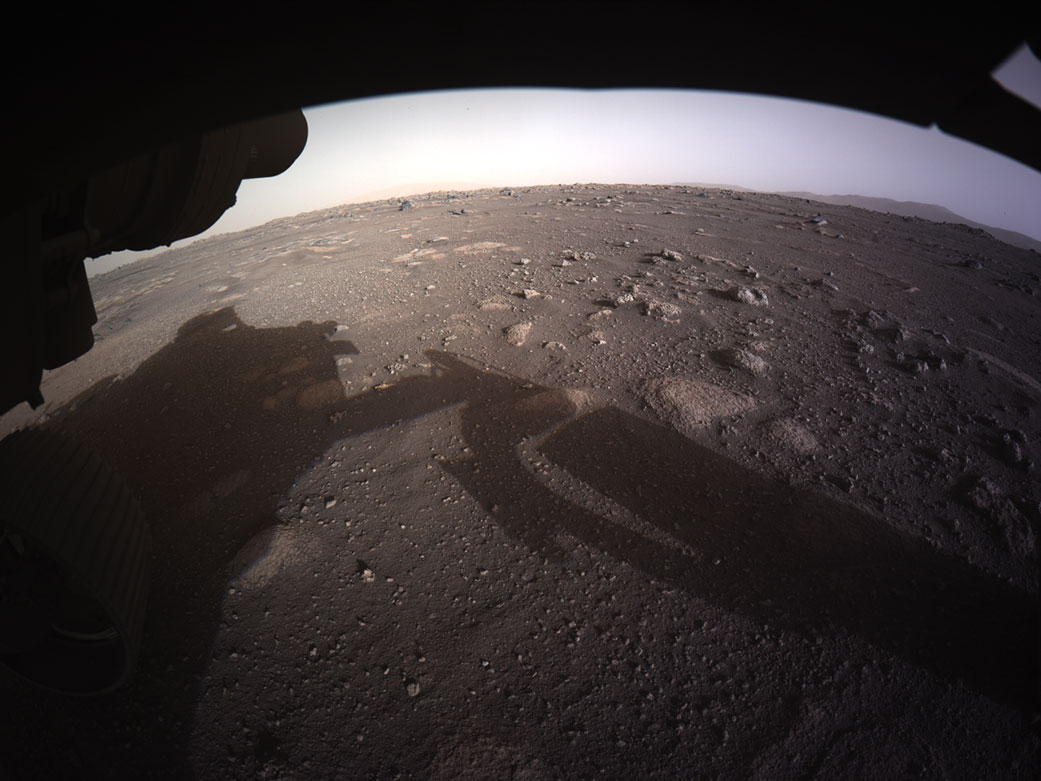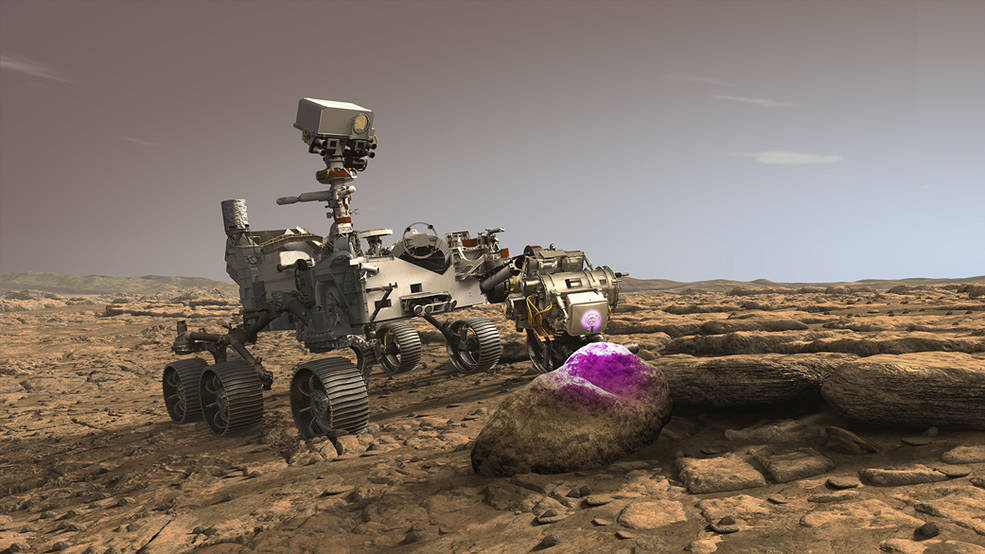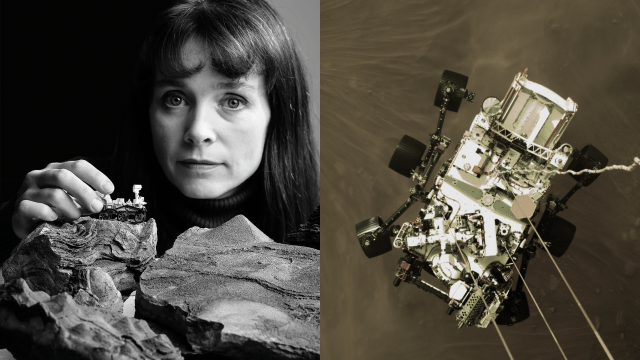When the NASA Mars rover Perseverance was dramatically airlifted through the Red Planet’s atmosphere and touched down on the iron-rich soil, geologist and astrobiologist Abigail Allwood was at home on Earth, watching the events unfold via livestream like the rest of us. Speaking over the phone the next day, her thought process was probably similar to yours: “Amazing — talk about incredible,” she said. “Excitement yesterday about landing and today about the landing site.” But in the months to come, Allwood will have a unique charge, one that years of terrestrial study have prepared her for: seeking out life on Mars.
The landing itself is a marvel. Once the rover defied Earth’s gravity to embark on the journey, it schlepped across roughly 193 million kilometres of space over the course of six months, finally hurtling downward at breakneck pace toward the spinning planet and alighting precisely (and without any immediately noticeable harm) in the 52-square-kilometre target zone set out for it. (Once Perseverance’s artificially intelligent navigation system had pinpointed its landing spot above the planet, it set down only 5 metres from that spot). Now on the west side of Jezero Crater, believed to be an ancient, dried-up river delta, Perseverance’s real work can begin, picking up on the foundational science Allwood has devoted decades to on Earth.
[referenced id=”1674185″ url=”https://gizmodo.com.au/2021/02/unreal-video-of-perseverance-landing-on-mars-will-take-your-breath-away/” thumb=”https://gizmodo.com.au/wp-content/uploads/2021/02/23/ppbsyjqhl1zlnwsobog0-300×169.gif” title=”Unreal Video of Perseverance Landing on Mars Will Take Your Breath Away” excerpt=”NASA has released stunning footage of the Perseverance rover landing on Mars, in what is a seminal achievement for the space agency.”]
“I feel that the whole thing has been some sort of a surreal sequence of very, very fortuitous events, coupled with some hard work,” Allwood, now a crucial member of the Mars 2020 team, said in a phone call. “You could do everything I did to a ‘T.’ But it wasn’t dependent on me… it was an alignment of the holes in the cosmic Swiss cheese.”
At least some of Allwood’s astronomic trajectory she attributes to a two-pronged inflection point in astrobiology: the embarkations of Vikings 1 and 2 to Mars at the turn of the 1980s and the discovery of what was thought to be a Martian meteorite with evidence of microscopic bacterial fossils in 1984. The events, which Allwood described as a “holy crap” moment for the field, occurred at the onset of her doctoral research at Macquarie University in Sydney.
So far, most of the modern hunt for Martian life has unfolded on Earth. Bound by the fiscal and technological limitations to extraterrestrial research, astrobiologists have extrapolated possible scenarios for life’s existence in the seemingly desolate cosmos by looking at the most barren stretches of our own planet, swathes that offer glimpses into deep time. Allwood has long probed for stromatolites, the oldest fossils of life on Earth, sedimentary concretions forged from the growth of single-celled bacteria, that indicate the earliest, microbial bedrock of life. To the untrained eye, the fossils look like if Sol Lewitt worked with sedimentary rock; their cross-sections can appear like a bunch of earth-toned wavy lines or concentric rings, nothing like something that was once alive.

Allwood dug into strata from the cool, rocky reaches of Greenland to the hotter, arid escarpments of Pilbara in Western Australia, looking for these earliest recognisable living structures, ones that scientists suspect would similarly occur in a primordial Mars, which was much wetter than the dusty, rusty sphere out there today. Some stromatolites, like those in Pilbara, precede the Cambrian explosion of biodiversity (about 540 million years ago, some 300 million years before dinosaurs) by billions of years. That’s where Allwood found the earliest known life on Earth in 2006, clocking in at nearly 3.5 billion years old. Coincidentally, that chronological benchmark is also when Jezero is thought to have become a lake. Inflowing water created channels at the western border, a river delta that could have hosted stromatolite-like life.
Since her doctoral work, Allwood has been focused on those extremely ancient layers of biological shenanigans. It’s only now, with the safe arrival of Perseverance, that such questions can be asked of another planet using a combination of state-of-the-art and off-the-shelf technologies. For Allwood, it’s not too different from the work on Earth and requires a certain detachment from the larger questions at play, as well as a greater focus on the microscopic details encoded in each rock.
“I’ve always dealt with rocks of incredible age from a planet that was literally alien compared to what we know here and now,” she said. So, too, was the Mars of 3.5 billion years ago alien to the Red Planet we now think of.
Even the first few images Perseverance beamed back to Earth have Allwood excited. Some of the rocks she suspects to be carbonate-bearing units, previously imaged from above by the Mars Reconnaissance Orbiter, indicate the project site in the crater’s west has significant potential in the search for biosignatures. Across Jezero is similarly compelling to Allwood. “The whole east side of the crater — we’re not even going to get to it — but I can see that there are evaporites there,” she said. “That’s like the Holy Grail, too rough to get to.”
Evaporites are the sedimentary remnants of water-soluble salts that remain on the ground after evaporation. Since water is a prerequisite for life, the longstanding Martian mandate has been to “follow the water,” leading NASA to places like Jezero. Evaporites like dolomite, halite, or gypsum — on Earth most obviously present in venues like Utah’s Great Salt Lake — could hold similar petrified biomarkers to those found in Earth’s stromatolites.

The great distance between the target rocks and the intrigued researchers aside, the challenges to finding ancient life also have plenty to do with how fossil evidence is found and then interpreted. If paleontologists look at fossils, and ichnologists look at the trace presences of those long-gone creatures in their footprints and burrows, researchers of the earliest biosignatures — on Earth or otherwise — are forced into a more phantasmal line of inquiry, what Allwood described in 2019 as the “trapped breath of insects. Textual and chemical ghosts.”
Even the ability to ask such questions depends on the miracle of the preservation of such evidence, over billions of years of geological and anthropogenic disruptions. (Thankfully, Mars seems to have been much more tectonically calm than our own planet and mercifully devoid of humanity). But now consider the distances at which those queries are being asked in Perseverance’s case, pinged through space with perhaps the slightest gossamer of hope for some useful data in the search. It seems improbable. But still, Allwood and the team ask the questions.
“We’ve always looked up at the sky and wondered what’s out there; is there any other life out there? Or is this it? Are we it? Are we alone, or is anyone else out there? Was there ever anyone else out there?” Allwood said. “With this mission, if the answer is yes, there was life, albeit 3.5 billion years ago, but there isn’t probably now, to me it says: ‘Critters of Earth: no, you weren’t alone. There was life on this planet, your very neighbouring planet. You live in a biological universe.’”
Allwood’s brainchild, the Planetary Instrument for X-ray Lithochemistry (PIXL, for short), is what launched her onto the Mars 2020 ballot and is one of the keys to unlocking those answers. One of seven instruments aboard Perseverance, PIXL is an X-ray spectrometer outfitted for remote operation, meaning that it uses a precise laser to isolate bits of Martian rock the size of a grain of salt for analysis. PIXL can detect 26 different elements — a veritable alphabet of Martian soil make-up — as well as how much of each element there is. It can paint a picture of the conditions on the Red Planet at the time those rocks were formed.

PIXL is constituted by an eggshell-white sensor head Allwood likens to “stormtrooper’s lunchbox,” which is attached to some rover-mounted electronics by a robotic arm. The sensor head is bordered by six legs that look like bionic lint rollers, which make minute adjustments to the orientation and location of the sensor head’s (on the order of 100 microns, about the width of a human hair). Such specificity is necessary to take accurate measurements, because PIXL takes hours to paint a complete chemical picture, and temperatures on Mars fluctuate enough throughout the day to cause Perseverance’s metal to expand and contract. Even though the instrument will work under cover of Martian night to make the measurements more accurate, if PIXL’s legs didn’t correct the sensor’s location, chemical analyses would be blurred beyond interpretation. (Important to remember is that the work is being done remotely, with the help of the rover’s AI, from over 209 million kilometres away.) The instrument builds on the X-ray spectrometer aboard Perseverance’s predecessor, Curiosity, by enhancing the instrument’s sensitivity and resolution at microscopic scales.
[referenced id=”1673727″ url=”https://gizmodo.com.au/2021/02/heres-whats-next-for-perseverance-rovers-journey-on-mars/” thumb=”https://gizmodo.com.au/wp-content/uploads/2021/02/20/uxepjhrxkyolqrdlhlzj-300×169.jpg” title=”Here’s What’s Next for Perseverance Rover’s Journey on Mars” excerpt=”NASA has a new toy to play with on Mars, but the space agency has some important work to do before the Perseverance rover is ready to start rolling through its new stomping grounds.”]
As unforeseeable as the twists and turns of Allwood’s career have been, launching and running a major arm of the Mars 2020 mission through the unique vintage of 2020 was one of the weirdest developments. NASA scientists all wore masks as they guided Perseverance down to ground, an omnipresent reminder of the ongoing pandemic. “Mission control,” as Allwood knows it this year, is “in bed with a pair of pajamas on,” which has stymied the sort of collaborative atmosphere she feels is important in understanding the ongoing work on Mars. “It prevents the kind of serendipitous conversations that are so, so useful, in either understanding a problem or thinking of how to solve them,” she said. “Ideas galore. That’s at the heart of science.”
Instead of astrobiological water cooler talk, those conversations unfold remotely, on screens around California and beyond. Those discussions will help the team figure out which rocks to target, what data is promising, and what may be less useful. Even in the best-case scenario of discovery, there will be no big ALIENS button to press (if only); however compelling, the scientific conclusions will be tentative and piecemeal.
“I think one thing I learned in Pilbara and Greenland is that there’s no such thing as a single smoking gun, and there’s no such thing as PIXL finding evidence, or whatever,” Allwood said. “There’s only we found this, MastCam found this, SuperCam found that,” referring to two other tools at Perseverance’s disposal. “You need to have several scales of observation that all have to sort of piece together to form sort of a complex tapestry, out of which forms the interpretation of ‘these things must have been biological, in a sense.’”
Though we hope they’ll find a compelling patchwork of hints at something extraordinary, it’s possible, even likely, that Perseverance doesn’t find much. Certainly, the observations the rover makes with PIXL and its other tools will greatly advance our understanding of Mars. But now everyone’s thinking about the search for life, which could be as fruitless as a cryptozoological hunt. (Anyone taking bets on what will come to light first, Martian fossils or a living thylacine?)
“I think if it [life] was anywhere [on Mars], it would be in Jezero, and we would have the ability to find it,” Allwood said. “I think it’s pretty significant if we don’t eventually find any evidence of life in Jezero or something like that, I think we can pretty much start to think, maybe… yeah, that life didn’t exist. That’s what I’m almost willing to say.”
Millions upon millions of microns await for observation. Perseverance’s surface observations are scheduled to last at least one Mars year (nearly two Earth years). PIXL works slowly. That said, Perseverance’s predecessor Curiosity has been trucking along well past its original mission date. Whatever Perseverance does — or doesn’t — find, the research to come will mark the outlandish end stage of a question that began being answered in the warm waters of Western Australia. Allwood’s team may not look at a Martian rock for at least a couple of months, as Perseverance continues to run diagnostics on how it fared in landing.
For Allwood, asking such questions about the nature of ancient life and the possibility of similar biological origins on other planets can incur a sense of “being made to feel infinitesimally small by what you’re looking at and what you’re trying to do.” Perhaps it’s best, then, to focus on the microscopic, with the intensity and patience of an X-ray beam. It’s only by looking there that we can understand the big picture, anyway.
